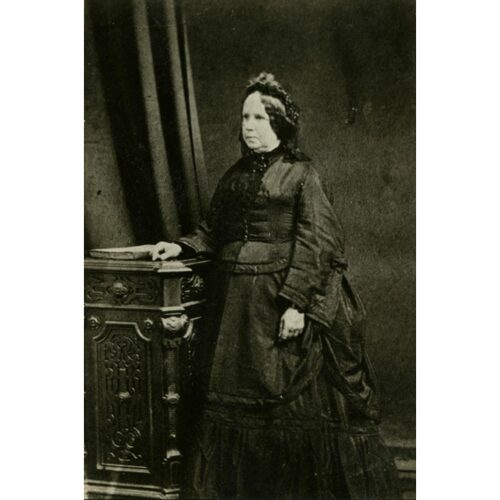![Éléonore D’Estimauville, Mme Louis-Paschal-Achille Taché, [Vers 1882], BAnQ Québec (P1000,S4,D83,PT9). Photographe inconnu. Original title: Éléonore D’Estimauville, Mme Louis-Paschal-Achille Taché, [Vers 1882], BAnQ Québec (P1000,S4,D83,PT9). Photographe inconnu.](/bioimages/w600.11847.jpg)
Source: Link
ESTIMAUVILLE, JOSÉPHINE-ÉLÉONORE D’ (Taché; Clément); b. 30 Aug. 1816 at Quebec, daughter of Jean-Baptiste-Philippe d’Estimauville, an army officer and office holder, and Marie-Joseph Drapeau; d. June 1893 in Montreal and was buried on 28 June at Les Éboulements, Que.
Fatherless from the age of seven, Joséphine-Éléonore d’Estimauville grew up in Quebec, on Rue Saint-Jean, in the home of her maternal aunts and her grandmother, Marie-Geneviève Noël*, the widow of Joseph Drapeau*. From 1829 to 1831 she studied with the Ursulines. On 16 July 1834, at Quebec, she married Louis-Paschal-Achille Taché, owner of part of the seigneury of Kamouraska.
The young couple made their home in the seigneurial manor-house. Before long, Joséphine-Éléonore began to complain of her husband’s drunkenness, absences, and mistreatment of her, even claiming that he was threatening to kill her. In December 1837 she decided to leave Kamouraska with her two children and go to her mother, who was living in William Henry (Sorel). In January Taché joined her there, but after more quarrelling he returned alone to Kamouraska the following month.
At William Henry, Joséphine-Éléonore had met George Holmes, a young unmarried physician. He had recently come to the town and frequently visited the presbytery of the parish priest, Jean-Baptiste Kelly*, who was related by marriage to the Drapeau family. She made use of the doctor’s services for her children and for herself, since she was in delicate health. Holmes and Joséphine-Éléonore quickly became lovers and their liaison could not be kept secret for long in the little town. Abbé John Holmes* even came from Quebec to try to reason with his half-brother, but to no avail.
According to testimony during subsequent legal proceedings, George Holmes resolved to get rid of Taché. In the autumn of 1838 he made two unsuccessful attempts to send someone to Kamouraska to poison the seigneur with arsenic. Then he approached Aurélie Prévost, dit Tremblay, a servant of Joséphine-Éléonore, who had been party to their affair from the start. Aurélie registered at an inn in Kamouraska under a false name. On 4 Jan. 1839 she succeeded in getting Taché to drink poison, but he did not die. Then Holmes himself set out to murder the unwanted husband. On 31 January he shot him twice in the head with a pistol, and buried his dead body under the snow in Anse Saint-Denis, where it was discovered three days later.
The inquest into the circumstances surrounding Taché’s death lasted from 5 to 28 Feb. 1839. Joséphine-Éléonore had been arrested and taken to jail in Montreal. She denied having had any part in the murder, and was released from prison on the 27th. However, she went on trial at Quebec on 21 Sept. 1841, charged with having administered poison to her husband or having caused it to be administered to him, on 4 Jan. 1839. The testimony of Aurélie, the sole witness who could have incriminated her, contained contradictory statements, and on the very day the trial began, the jury acquitted her.
On 18 May 1843, at Quebec, Joséphine-Éléonore d’Estimauville was remarried, this time to notary Léon-Charles Clément. They settled down at Les Éboulements and had six children. She never again saw George Holmes, who had fled to the United States after the murder to avoid being brought to trial. There he had been arrested and imprisoned, but he was set free early in 1840 after the American authorities turned down a request for extradition by the government of Lower Canada. Soon after his release he disappeared without a trace.
The murder of Taché caused a great stir at the time, given the prestige of the families involved in the affair. In the late 19th century it re-emerged in Georges-Isidore Barthe’s Drames de la vie réelle, roman canadien (Sorel, [1896]). In 1970 these same events served as the inspiration for Anne Hébert’s fine novel Kamouraska (Paris), which was brought to the screen in 1973 by film-maker Claude Jutra*.
AC, Saguenay (La Malbaie), État civil, Catholiques, L’Assomption (Les Éboulements), 28 juin 1893. ANQ-Q, CE1-1, 31 août 1816, 16 juill. 1834, 18 mai 1843; CE3-3, 22 juin 1813, 7 févr. 1839; P-107. DOLQ, 1: 201–2; 5: 476–81. Sylvio Leblond, “Le drame de Kamouraska d’après les documents de l’époque,” Cahiers des Dix, 37 (1972): 239–73.
Cite This Article
Céline Cyr, “ESTIMAUVILLE, JOSÉPHINE-ÉLÉONORE D’ (Taché; Clément),” in Dictionary of Canadian Biography, vol. 12, University of Toronto/Université Laval, 2003–, accessed January 1, 2026, https://www.biographi.ca/en/bio/estimauville_josephine_eleonore_12E.html.
The citation above shows the format for footnotes and endnotes according to the Chicago manual of style (16th edition). Information to be used in other citation formats:
| Permalink: | https://www.biographi.ca/en/bio/estimauville_josephine_eleonore_12E.html |
| Author of Article: | Céline Cyr |
| Title of Article: | ESTIMAUVILLE, JOSÉPHINE-ÉLÉONORE D’ (Taché; Clément) |
| Publication Name: | Dictionary of Canadian Biography, vol. 12 |
| Publisher: | University of Toronto/Université Laval |
| Year of publication: | 1990 |
| Year of revision: | 1990 |
| Access Date: | January 1, 2026 |



